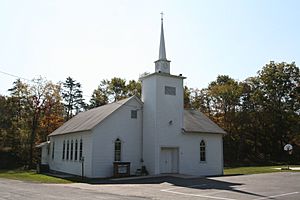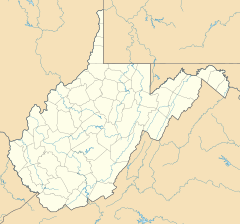Antioch, West Virginia facts for kids
Quick facts for kids
Antioch
|
|
|---|---|

Antioch United Methodist Church
|
|
| Country | United States |
| State | West Virginia |
| County | Mineral |
| Elevation | 1,079 ft (329 m) |
| Time zone | UTC-5 (Eastern (EST)) |
| • Summer (DST) | UTC-4 (EDT) |
| GNIS feature ID | 1549566 |
Antioch is a small, unincorporated community in Mineral County, West Virginia, United States. An unincorporated community means it's a group of homes and businesses that isn't officially a city or town with its own local government. Antioch is part of the larger Cumberland, MD-WV Metropolitan Statistical Area.
You can find this village along a branch of Mill Creek. It's located where the creek leaves Grayson Gap, on the east side of Knobly Mountain. Antioch sits at the intersection of Mikes Run Road and Knobley Road. It is also about three miles south of U.S. Route 50.
Contents
The History of Antioch
Early Settlers and the First Mill
The first European settlers arrived in the Antioch area in the late 1700s. One of the earliest families to settle permanently was Samuel Barker Davis and his family. They moved to Antioch in 1787 from Winchester, Virginia.
Samuel Barker Davis was a veteran of the American Revolutionary War. He built a gristmill, which is a mill for grinding grain into flour. He also built a log residence, or home. Both of these buildings are still standing in Antioch today!
The Mill's Changes Over Time
The gristmill is a four-story wooden building. It was built using a special method called mortise and tenon construction. This is a strong way to join pieces of wood together without using metal fasteners.
In 1880, the mill was updated by its owner, Brasher Rogers. Later, in 1918, D.W. Billmyer owned the mill. He changed it to process wool instead of grain, making it a woolen mill. This woolen mill kept working until the 1950s. When it closed, the machinery was sold to a museum in Massachusetts.
Historic Places to See
Antioch has several interesting historic sites. These include the original Davis log cabin, built in 1787, and the woolen mill, which also dates back to 1787. The Antioch Methodist Church is another historic building in the community.
Nearby, you can also find a monument marking the birthplace of Nancy Hanks Lincoln. She was the mother of Abraham Lincoln, one of America's most famous presidents.
Where Did the Name Come From?
The community of Antioch got its name from a city called Antioch in West Asia.
See also
 In Spanish: Antioch (Virginia Occidental) para niños
In Spanish: Antioch (Virginia Occidental) para niños



